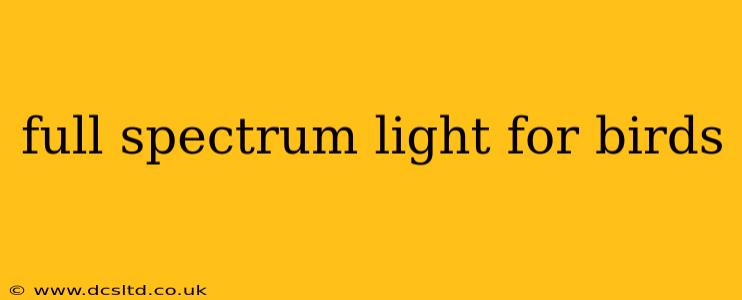Full spectrum lighting is becoming increasingly popular among bird owners, promising a healthier and happier life for their feathered friends. But what exactly is full spectrum light, and does it truly benefit birds? This comprehensive guide delves into the science behind full spectrum lighting, exploring its advantages, potential drawbacks, and how to choose the right lighting for your avian companions.
What is Full Spectrum Lighting?
Full spectrum lighting aims to mimic natural sunlight, providing a broader range of wavelengths than typical incandescent or fluorescent bulbs. Sunlight contains a vast spectrum of colors, each with its own wavelength and energy level. Full spectrum bulbs attempt to reproduce this, encompassing ultraviolet (UV) light, which is crucial for many biological processes. This is in contrast to standard lighting which often lacks sufficient UV and other beneficial wavelengths.
Does Full Spectrum Light Benefit Birds?
Many bird owners believe that full spectrum lighting offers several significant benefits for their pets. These benefits are often tied to the improved imitation of natural daylight.
Improved Vitamin D3 Production
Sunlight is essential for Vitamin D3 production in many animals, including birds. Vitamin D3 is vital for calcium absorption, bone health, and overall well-being. Full spectrum bulbs, with their UV component, can help birds synthesize Vitamin D3, especially during winter months or when birds are kept indoors with limited sun exposure.
Enhanced Mood and Behavior
Exposure to natural light cycles influences a bird's circadian rhythm, regulating sleep-wake patterns, hormone production, and overall mood. Full spectrum lighting helps to regulate these cycles, potentially leading to improved behavior, reduced stress, and increased activity levels. A happier, more active bird is a healthier bird.
Brighter, More Vibrant Colors
The broader spectrum of light provided by full spectrum bulbs can make a bird's plumage appear more vibrant and colorful. This is because the light accurately reflects the bird’s natural hues, making them appear more attractive and healthy.
Stimulation of Breeding Behaviors
For some bird species, the increased light intensity and spectrum mimicking natural spring light can trigger breeding behaviors. This is particularly relevant for breeders aiming to encourage reproduction. However, it's crucial to understand the specific light requirements of your bird species; improper lighting could be detrimental.
Potential Drawbacks of Full Spectrum Lighting
While the benefits are significant, it's important to acknowledge potential drawbacks:
- Overexposure: Too much UV light can be harmful to birds, potentially leading to skin damage or eye problems. It's crucial to use appropriate bulbs and ensure proper placement to avoid overexposure.
- Heat Generation: Some full spectrum bulbs generate more heat than others. Excessive heat can be uncomfortable or even dangerous for birds, particularly in warmer climates or smaller enclosures.
- Cost: Full spectrum bulbs can be more expensive than standard lighting options.
- Not a Replacement for Natural Sunlight: While beneficial, full spectrum lighting shouldn't replace natural sunlight entirely. Birds still benefit from fresh air and the broader environmental stimuli provided by outdoor environments (when safe and appropriate).
Choosing the Right Full Spectrum Light for Your Bird
Choosing the appropriate full spectrum lighting for your bird involves several considerations:
- Bird Species: Different bird species have varying light requirements. Research the specific needs of your bird's species to determine the appropriate UV output and overall light intensity.
- Bulb Type: Various full spectrum bulbs are available, including LEDs, fluorescent tubes, and compact fluorescent lamps (CFLs). LEDs are often preferred for their energy efficiency and longevity.
- UV Output: The UV output (measured in UVA and UVB) should be carefully considered, following recommendations for your specific bird species. Overexposure to UV can be harmful.
- Bulb Placement: The bulb should be placed at an appropriate distance from the bird to avoid overheating and provide even illumination.
How Long Should the Light Be On?
The duration of light exposure should mimic the natural daylight cycle for your bird’s species and geographical location. Researching natural daylight hours in your area during different seasons will help you determine the appropriate on/off times.
Can I use Full Spectrum Bulbs for all Birds?
While generally beneficial, full spectrum lighting is not a universal solution. Some bird species may not require or even benefit from supplemental lighting. Always research the specific needs of your avian companion before introducing any new light source.
Are there any Alternatives to Full Spectrum Lighting?
If full spectrum lighting isn't suitable for your bird, you can focus on providing a stimulating and enriched environment, ensuring adequate ventilation, and minimizing stress. Regular vet check-ups are also vital for maintaining your bird's health.
Choosing the right full spectrum lighting can contribute positively to your bird's health and well-being. However, responsible use, informed choices, and careful consideration of your bird's specific needs are crucial for obtaining the benefits while avoiding potential risks. Remember to consult with an avian veterinarian for personalized advice.
